Are You Making These Carseat Mistakes?

![]()
![]()
![]()
![]()
![]()
Top 5 Carseat Mistakes
 Most parents think, “I got this,” when they look at a carseat. I mean, really, it’s just some straps that go over your kid, right? Everyone who has a kid has to use a carseat, and we all know there are some parents out there barely qualified to have kids in the first place who are able to get from point A to point B and keep their offspring alive, so it’s not rocket science, right? Wrong. Sometimes we make mistakes that we look back on and say, “I can’t believe my child survived my parenting!” It’s a saying in our house that we’re not saving for college; we’re saving for the therapists’ bills, lol. Let’s look at some very common carseat mistakes and see their simple fixes so your offspring can ride safely enough to make it to college… or therapy sessions—whichever way your family sways.
Most parents think, “I got this,” when they look at a carseat. I mean, really, it’s just some straps that go over your kid, right? Everyone who has a kid has to use a carseat, and we all know there are some parents out there barely qualified to have kids in the first place who are able to get from point A to point B and keep their offspring alive, so it’s not rocket science, right? Wrong. Sometimes we make mistakes that we look back on and say, “I can’t believe my child survived my parenting!” It’s a saying in our house that we’re not saving for college; we’re saving for the therapists’ bills, lol. Let’s look at some very common carseat mistakes and see their simple fixes so your offspring can ride safely enough to make it to college… or therapy sessions—whichever way your family sways.
1. Loose Installation
Whether using the lower LATCH connectors or the seat belt for installation, your carseat moves more than 1” when you give a tug at the belt path—it shouldn’t do that. Make sure you tug at the belt path only; that’s the only place where the carseat is connected to the vehicle. If you check for tightness anywhere else on the carseat, it’s going to move more than 1″. There’s nothing holding it to the car there, right?
Let’s define “tug”. A tug is like a handshake you’d give to someone you’d meet at a party or a shake on a shoulder that doesn’t move someone’s head back and forth (heh, you don’t want to give them whiplash). You use your non-dominant hand to give this tug so you’re not tempted to shake the rivets out of the seat.
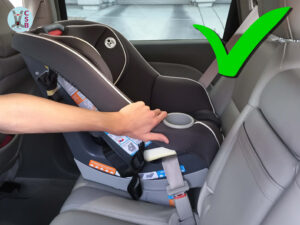
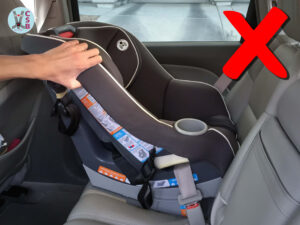
Can’t Lock the Seat Belt (Loose Installation Corollary)
Sometimes your installation is loose because you can’t figure out how to lock your seat belt to keep it tight on the carseat. Seat belts lock either at the retractor or at the latchplate. All model year 1996 and newer vehicles must have locking seat belts and some vehicles manufactured before 1996 have them as well. The retractor spools up all the length of the belt and is hidden inside the wall of the vehicle or inside the vehicle seat back (sometimes the floor!). At least 90% of all modern vehicles have switchable retractors that can lock the seatbelt to hold a carseat tightly in place.
This is how you test for a switchable retractor:
Pull the shoulder belt portion of the seat belt out of the retractor slowly and smoothly until you reach the end and can’t pull it out any further.
Then feed a few inches of the belt back into the retractor.
Listen for a ratcheting/clicking sound as the seatbelt feeds back into the retractor in the locked mode (although some retractors are very quiet, most will make a noticeable clicking sound once they are switched into locked mode).
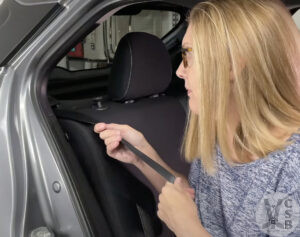
Stop after feeding a few inches of the belt back in and try to pull it back out again. If it won’t come back out, it’s locked and now you know that this seat belt has a switchable retractor that you must switch to the locked mode if you are installing a carseat in this seating position.
Other seat belts lock at the latchplate (male end of the seat belt). These are mostly found on Chrysler, Dodge and Jeep vehicles. To see if your seat belt locks in these vehicles, buckle the seat belt and pull up on the lap belt. If it holds tight, your latchplate locks.
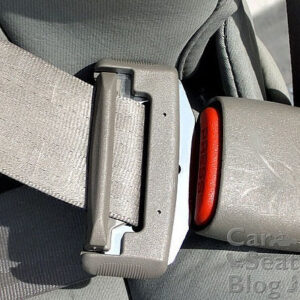
If you can’t get your seat belt to lock because your car was made before 1996, you have to use either a carseat with a built-in lockoff or a locking clip. If you want to read more about locking clips, you can click here. Lockoffs that are built into certain carseats are much easier to use than a locking clip and worth the extra price. Read about which carseats have lockoffs here.
2. Loose Harness
Yeah, you can’t just buckle the harness, it has to be snug on the kid or they’ll go flying out of the seat. If you can take a pinch of the harness above the chest clip, the harness is too loose so pull it tighter.
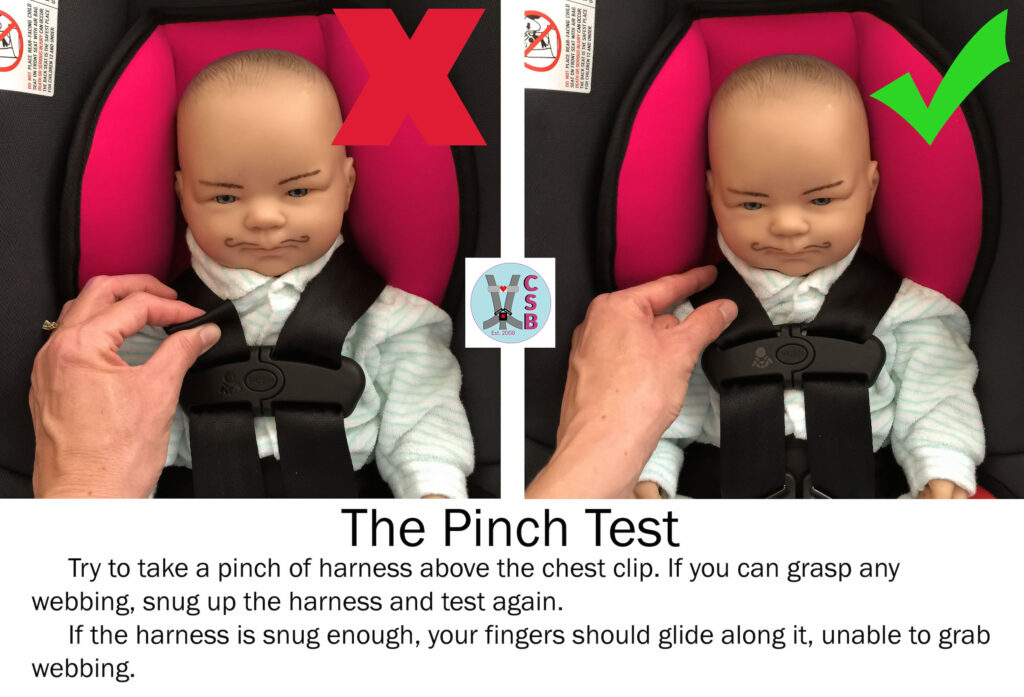
3. Chest Clip or Belly Clip?
You know those plastic pieces that clip together across the kid’s middle? That’s called a chest clip. Some carseat manufacturers’ get all uppity and call it a harness retainer clip. Call it what does and where it goes and you’ll never forget! Chest clip. The top of the chest clip is placed at the armpits. Any higher and it’s at the kid’s throat, especially for babies. Any lower and it may not be able to do its job as a pre-crash positioner.
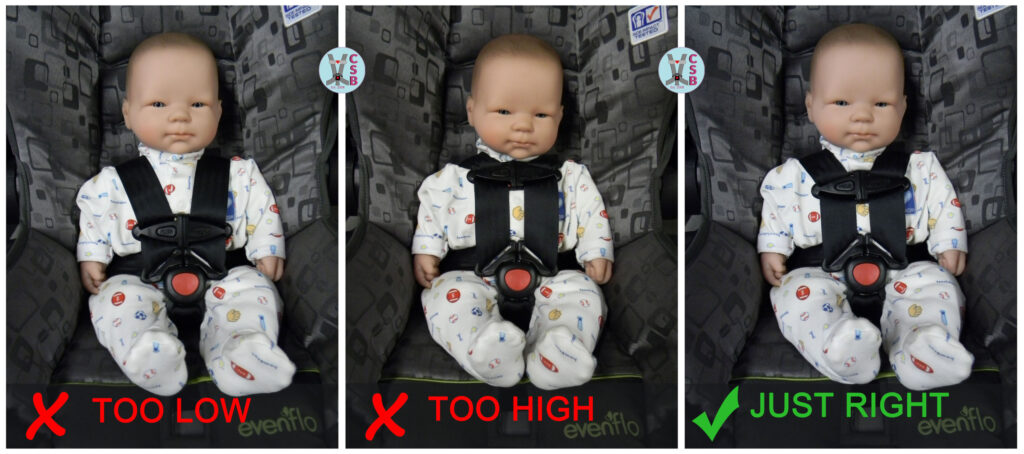
4. Trusting Your Pediatrician for Carseat Advice

This topic is so important, we even have a whole Mythbusters article dedicated to it. Do the initials “CPST” follow your pediatrician’s MD after their name? If not, they’re not qualified to give you carseat advice. Just like I’m not qualified to give you medical advice on your child’s rash (gee, that really does look like Ichthyosis en confetti—you should have that checked out), your ped is not qualified to give you advice on vehicle safety matters. Between charting, keeping up with ever-changing youth medicine, and making hospital rounds, most peds simply don’t have the time to keep up with the dynamic field of child passenger safety unless it’s a special interest. That’s why you come to us for answers on vehicle safety.
5. Turning Forward Too Soon
You may not admit it online, but turning your wee one forward too early is really dangerous. I’ve heard all the arguments in my 22 years of tech-ing: my child’s legs hurt because they’re scrunched, my best-friend’s-mother-in-law’s-phlebotomist’s-daughter’s-pediatrician told her to turn her son forward at 12 months because of a risk of hip injury, my child has to be able to see the iPad screen we spent top-dollar for, and so on. The truth is, if you turn your kid forward before they outgrow the weight and height limits of their rear-facing carseat (and we mean convertible or all-in-one, not infant seat), *you’re* the one who is uncomfortable with the idea of rear-facing, not your child. Studies and years of rear-facing children have shown that rear-facing is not only safe, it’s loads safer for kids. After all, it’s (relatively) easy to fix a broken leg, but you can’t fix a broken spinal cord.
It’s so important to rear-face your toddler that some carseat manufacturers now mandate rear-facing to age 2, at least for some of their carseat models, not to mention some states. Britax requires a 2-year and 25 lbs. minimum on all of their forward-facing harness-2-booster seats. And Evenflo says that your kids must be 2 before they can be turned forward-facing in their convertible seats. I’m not pulling your leg—it’s right there in the manual. Chicco has a 2-year minimum age limit too, so these are a few manufacturers to have a minimum age to turn forward. The age limit may not be on the side of the box when you purchase the seat so you may not know beforehand which manufacturers require it, so at least make an effort to rear-face to age 2 since it’s an industry standard.
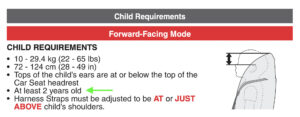
Commercials on TV claim that the best way to start your baby’s life is to use the best diapers or best formula (if you can’t breastfeed, of course). We feel the very best thing you can do for your kid in the child passenger safety world is to use an appropriate carseat or booster on every single ride. After the infant seat is outgrown, continue to rear-face your child until they reach the rear-facing height or weight limit of their convertible/all-in-one carseat. And install the seat tightly. And tighten the harness appropriately. And make sure the chest clip is properly placed.
The crazy thing about kids and carseats is that there are so many things that can go wrong with them that we need an entire profession to help parents get it right! I remember making some of these mistakes—and more. Aye yi yi. It’s amazing we’re all still here.







